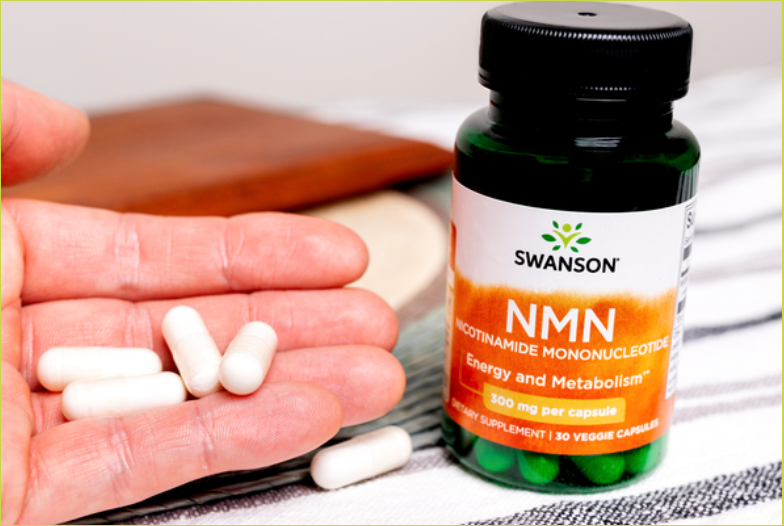Your body needs nicotinamide adenine dinucleotide (NAD+) for everything from improving your immune system to repairing your DNA.1 As you get older, your levels of NAD+ start to drop. This can result in an array of side effects like increased signs of aging, reduced metabolism, higher levels of fatigue, and increased oxidative stress. That's where nicotinamide mononucleotide (NMN) comes in. It's a naturally occurring compound that helps your body produce more NAD+, especially as you age. That's why NMN supplements have recently been spotlighted as a way to enhance your wellness and support healthy aging over the years.
Benefits of NMN: What is NMN Good For?
When you take NMN, your body converts this molecule (technically known as a "nucleotide") into NAD+. Research shows that by giving your body the building blocks it needs to produce more NAD+, NMN can demonstrate significant benefits in numerous ways, all associated with higher levels of NAD+.
In contrast, research has yet to show that taking NAD+ itself effectively changes your body’s levels of NAD+. This suggests that NMN may be more effective than taking NAD+.
Improved Immune Function
As a precursor for NAD+, NMN supplements may improve the function of macrophages (a type of white blood cell) and enhance your immune system to make your defenses stronger, especially as you get older.3
Maintain Healthy Blood Sugar Levels
In the first clinical trial of its kind, researchers found that NMN supplements may improve insulin efficiency and could support healthier blood glucose levels.4
Enhanced Muscle Strength
After age 30, you lose up to 8% of your muscle mass every decade.5 By increasing NAD+ levels, you may improve your muscle mass and strength6 — this doesn't just keep you active as you age, but also guards against risks related to muscle weakness, like shaky balance or a higher risk of tripping and falling.
Better Overall Wellness and Healthier Aging
Since you need NAD+ for DNA repair and the functioning of all of your body's cells,1 NMN's ability to support healthy NAD+ levels means you could notice improvements in almost every area of health and wellness even beyond the NMN benefits noted above — especially as it relates to getting older.
Possible Side Effects of NMN: What is the Risk of Taking NMN?
Most studies on NMN and NAD+ precursors have not yet shown any significant side effects6, although ongoing research continues to fully establish its safety profile.
Who Should Avoid Taking NMN?
If you're pregnant or have a pre-existing health condition, always consult with your doctor before adding a new supplement to your daily routine.
What Other Risks May Be Associated with NMN Supplements?
While researchers generally consider NMN supplements to be safe7, some people may experience mild symptoms as you would when taking many other dietary supplements, such as:
- Cramping or abdominal pain
- Diarrhea or loose stools
- Gas and bloating
Some NMN supplements may also contain other ingredients, such as resveratrol (from grapes) or troxerutin (from buckwheat) in order to enhance the efficacy of NMN. Carefully review the ingredients label on any and all supplements you take to ensure secondary ingredients don't interact with other supplements you take, or any medications you're currently on.
NMN Dosage
Every clinical study on NMN has used different dosages, ranging from as low as 250 mg a day to more than 1,250 mg a day.8 For general health and well-being, most studies have stayed in the lower range, while studies on athletes and very physically active individuals have erred towards the higher range. The best NMN supplements hover in the middle to meet everyone's needs — you can increase your dose according to your requirements.
If you have specific concerns, your doctor can recommend the right dosage for your age, lifestyle, and needs.
How Can I Increase My NMN?
Taking an NMN supplement is the most effective way to quickly boost your NMN levels and support healthy NAD+ production. However, NMN can also be found in trace amounts — emphasis on trace — in foods such as:9, 10
- Avocado
- Broccoli
- Cabbage
- Cucumber
- Edamame (soybeans)
- Tomatoes
However, you would have to eat a lot of these foods to get a significant amount of NMN, which is why taking NMN supplements is so beneficial. For instance, tomatoes have 0.26-0.30mgj of NMN per 100 grams,10 which means if you wanted to get 250 mg of NMN, you would have to eat more than 96.2kg (212 pounds) of tomatoes a day.
Who Can Benefit from Taking NMN?
NMN is often thought of as an anti-aging supplement, but its benefits aren't just for those who are middle-aged or seniors. In fact, research shows that NAD+ levels begin to drop in young adulthood.11 Since NAD+ (and therefore NMN) plays a key role in basic cell functioning, including your immune system, you may want to consider it if you're seeking enhanced energy, improved aging, better strength, a stronger immune system, and an overall boost in vitality.
Get Started with the Best NMN Supplements Today
Our best-selling NMN supplements are sourced from 98% pure nicotinamide mononucleotide. And at a single dose of 300 mg, you can experience the health-boosting benefits of NMN quickly and effectively.
You be well, now.
Swanson
*These statements have not been evaluated by the Food and Drug Administration. These products are not intended to diagnose, treat, cure, or prevent any disease.

About Dr. Christopher Oseh
Christopher Oseh, MD, is a trained primary care physician leveraging almost a decade of clinical experience managing and counseling patients toward better health through positive lifestyle changes. He has a strong track record of treating and co-managing individuals with chronic illnesses.
*These statements have not been evaluated by the Food and Drug Administration. These products are not intended to diagnose, treat, cure, or prevent any disease.
Sources
- NAD+ metabolism and its roles in cellular processes during ageing. Nat Rev Mol Cell Biol. Read source
- Oxidative Stress: Harms and Benefits for Human Health. Oxid Med Cell Longev. Read source
- NAD-biosynthetic pathways regulate innate immunity. Nature Immunology. Read source
- Anti-aging compound that improves metabolic health in mice improves muscle glucose metabolism in people. Washington University School of Medicine. Read source
- Muscle tissue changes with aging. Curr Opin Clin Nutr Metab Care. Read source
- Loss of NAD Homeostasis Leads to Progressive and Reversible Degeneration of Skeletal Muscle. Cell Metab. Read source
- Nicotinamide adenine dinucleotide: Summary Report. UMB Digital Archive. Read source
- Oral Administration of Nicotinamide Mononucleotide Is Safe and Efficiently Increases Blood Nicotinamide Adenine Dinucleotide Levels in Healthy Subjects. Front Nutr. Read source
- Safety evaluation of β-nicotinamide mononucleotide oral administration in healthy adult men and women. Scientific Reports. Read source
- Natural compound reduces signs of aging in healthy mice. Washinton University in St. Louis. Read source
- Nicotinamide Mononucleotide: Exploration of Diverse Therapeutic Applications of a Potential Molecule. Biomolecules. Read source
- Age-related NAD+ decline. Exp Gerontol. Read source



